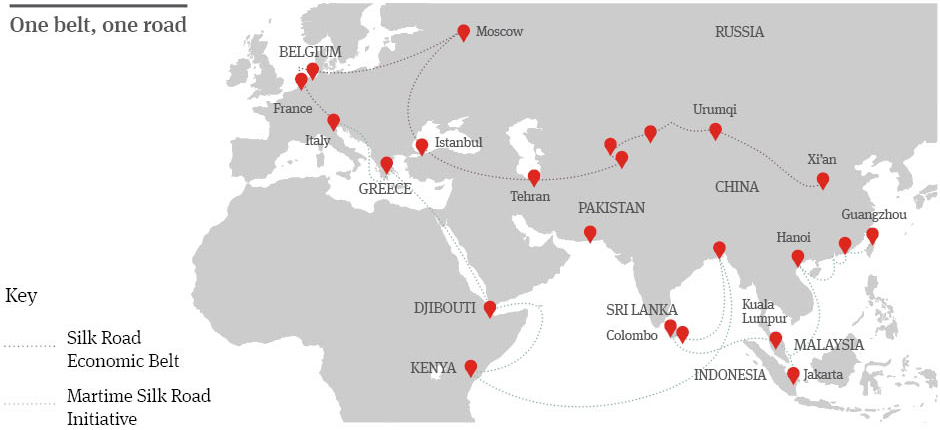The Belt and Road Initiative (BRI) or the Silk Road Economic Belt and the 21st century Maritime Silk Road is a development strategy proposed by the People’s Republic of China (PRC) government which focuses on connectivity and cooperation spanning across countries in the Asia Pacific area and Central and Eastern Europe.

A map indicating the coverage of the BRI, also known as the One Belt and One Road Initiative.
The BRI is one of the largest infrastructure and investment projects in history, covering more than 68 countries, including 65 percent of the world’s population and 40 percent of the global GDP as of 2017. It is an ambitious framework envisaging co-operation between countries on areas such as infrastructure investment, education, construction materials, railway and highway, automobile, real estate, power grid, and iron and steel.
Since its announcement by President Xi of the PRC in late 2013, over 600 contracts have been signed by Chinese enterprises for projects in countries along the BRI routes. It has been projected that Asia alone needs about US$8 trillion worth of basic infrastructure projects for the ten-year period from 2010 to 2020.
The BRI brings new investment opportunities but also unchartered risks requiring careful management. The involvement of countries with different stages of development and widely varying legal, political and economic systems means that risks must be properly managed with the choice of effective dispute resolution mechanisms at the heart of that risk management process.
Arbitration for BRI projects
By their very nature, BRI projects are complex, high-value, high-public interest, long-term, capital intensive, multi-party, multi-contract and crossborder. One of the key benefits of the arbitration process is its neutrality – it is separate from and largely independent of the local court system of the investee countries. Risks and concerns of litigating in foreign courts include the applicable law, the impartiality of the local judges, and the international recognition and enforceability of local court judgments.
The portability of arbitral awards is another major benefit. There are over 70 countries within the BRI, with only 5 countries being non-signatories to the New York Convention. Those countries are: Iraq, Maldives, Timo-Leste, Turkmenistan and Yemen. For signatory countries (which constitute the vast majority), enforcement of international arbitration awards should be relatively straightforward.
Mediation as an alternative dispute resolution mechanism that is much more widely embraced in civil law jurisdictions than common law jurisdictions, and likely favoured by Chinese parties, should not be overlooked. This is particularly the case with mediation being combined with arbitration in Med-Arb, Arb-Med-Arb, etc. processes which can result in an award that benefits from the New York Convention enforcement regime.
Arbitral institutions’ response to BRI
The last several years have seen an exponential proliferation of institutional arbitration in the international arbitration scene. This appears to be a result of both the recognition of certain civil law jurisdictions of only institutional and not ad hoc arbitration, and intense competition among arbitral institutions to provide better service and to improve the range of tools available to modernise the arbitral process to close the gap between dispute resolution by arbitration and by court litigation. There is no reason to believe that similarly keen competition among arbitral institutions will not arise to seek out opportunities in the BRI dispute resolution arena.
The above is abundantly clear in recent amendments of the rules by various arbitral institutions, some of which are of a more general in nature while others are BRI focused. To maintain competitiveness, most of the major institutional rules have similar features. However, significant differences remain, such as
Confidentiality
The institutions’ approach to confidentiality illustrates the differences which arise. For example, the ICC Rules do not contain any express confidentiality provisions. By contrast, the AAA/ICDR Rules expressly prevent the disclosure of confidential information during the proceedings and there is an obligation of confidentiality in relation to the award (except that the AAA/ICDR may publish redacted extracts). Similarly, the LCIA Rules provide that the arbitral proceedings, material created for the purpose of those proceedings and the award are all to be kept confidential.
- Scrutiny
The extent to which awards are scrutinised also varies significantly. Awards made by ICC arbitrators are scrutinised and approved by the ICC court to maintain consistency and a high standard of award-writing. Certain other institutions e.g. CIETAC also scrutinise awards. By contrast, the HKIAC and the SIAC do not scrutinise awards.
- Fees
Fee structures can also differ, with some institutions charging on the basis of the amount in dispute and others charging on a flat hourly rate basis. As much as possible, advisers need to be informed about these differences so that the end-user can choose the institution that is most suitable for their dispute.
The HKIAC is currently undertaking a consultation with a view to a fairly significant revision of its 2013 administered arbitration rules. The consultation has included proposed revisions in the following areas
- Online Document Repository. • Alternative Means of Dispute Settlement (e.g. “Arb-Med-Arb”).
- Multilingual Procedures, i.e. to allow arbitral proceedings to be conducted in two or more languages.
- New Grounds for Joinder, i.e. joinder of a non-party to the arbitration agreement giving rise to the arbitration in question, and joinder of a party under a separate arbitration agreement under the same rules.
- Expanded provisions for single arbitration under multiple contracts.
- Concurrent Proceedings.
- Third Party Funding.
Each of the above could have significant implications in terms of bringing the HKIAC Rules up to date and improving the efficiency and effectiveness of the arbitral process for BRI disputes.
In March 2018, the ICC International Court of Arbitration announced the establishment of a commission to address dispute resolution potentials in relation to the BRI. According to a spokesperson of the commission, there is a concerted effort to encourage mediation clauses in BRI agreements, with provision for arbitration if mediation fails.
Late 2017 saw CIETAC announcing the adoption of a set of special international investment arbitration rules aimed at promoting the effective and expeditious resolution of BRI related investor claims. The CIETAC Rules are innovative in the sense that cases will be heard by the newly established Investment Disputes Resolution Center in Beijing, and can also be referred to and administered by CIETAC’s Hong Kong Arbitration Center if the parties so wish. The rules further permit the use of third party funding which must be disclosed upfront to the counter-party, arbitrators and CIETAC.
The latest set of SIAC Rules, introduced in August 2016, already included multiple contract arbitrations, joinder of additional parties and early dismissal of claims and defences (the last of which is the subject of the HKIAC’s current consultation). As to the combination of mediation and arbitration, Singapore had had an Arb-Med-Arb protocol in place since 2014. BRI projects will present a unique opportunity for parties to take a fresh look at how best to use the protocol to their advantage.
Conclusion
It is important for investors to have the right tools to manage any accompanying risks in order to benefit from BRI opportunities. International arbitration, with its many benefits and advantages, unquestionably should be at the top of parties’ minds as a preferred choice of dispute resolution mechanism. With the multiplicity of institutions vying for a share of the BRI dispute resolution pie, parties are well advised to study the rules of the different institutions carefully as well as the law of the seats where the institutions commonly operate to fully understand the pros and cons of choosing any particular institution. This is fundamentally important to successful risk management for BRI projects.




